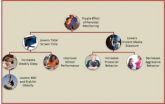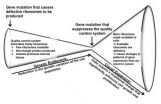(Press-News.org) AMES, Iowa – Parents may not always see it, but efforts to limit their children's screen time can make a difference. A new study, published in JAMA Pediatrics, found children get more sleep, do better in school, behave better and see other health benefits when parents limit content and the amount of time their children spend on the computer or in front of the TV.
Douglas Gentile, lead author and an associate professor of psychology at Iowa State, says the effect is not immediate and that makes it difficult for parents to recognize. As a result, parents may think it is not worth the effort to monitor and limit their children's media use. But Gentile says they have more power than they realize.
"When parents are involved it has a powerful protective effect across a wide range of different areas that they probably never would have expected to see," Gentile said. "However, parents aren't likely to notice that putting limits on the children's media is having these effects seven months later."
Considering that children average more than 40 hours of screen time a week, not counting time spent on a computer at school, even small changes can make a difference, researchers said. They are not suggesting parents completely eliminate screen time, but find a healthy balance.
The study found there is a ripple effect associated with the benefits of limiting both screen time and media content. Gentile is not surprised to see a direct impact on sleep, academics and behavior. However, limited screen time also indirectly affects body mass index. The study found that children got more sleep if parents limited screen time, which also resulted in lower risk of obesity. Parents limiting exposure to violent media resulted in increased prosocial behavior and lowered aggressive behavior seven months later.
Researchers analyzed the media habits of more than 1,300 school children who were recruited to participate in an obesity prevention program. Students and parents were surveyed about everything from screen time limits, to violent media exposure, to bedtimes and behavior. Teachers reported grades and commented on student behavior and school nurses measured each student's height and weight.
Data were collected at the start of the program and seven months later at the end of the program. By looking at these factors collectively with a group of children over a school year, it was easier for researchers to identify patterns that are hard to recognize in individual children.
"As parents, we don't even see our children get taller and that's a really noticeable effect. With media, what we're often looking for is the absence of a problem, such as a child not gaining weight, making it even more difficult to notice," Gentile said.
"Even with changes that we do notice, we really don't recognize in the moment how all these things are related to each other across time," he added. "Yes, as screen time goes up, school performance goes down, but that doesn't happen overnight. If I watch a lot of TV today, I don't get an F in my class tomorrow."
Doctors can make a difference, too
The American Association of Pediatrics recommends no more than one to two hours of screen time a day for children two years and older. Reality far exceeds those recommendations, which might explain why doctors feel it is futile to talk with parents about guidelines for media use, Gentile said. The study provides further evidence of why pediatricians need to have that conversation.
"Hopefully, this study will give pediatricians a better sense of efficacy that it's worth taking the time to talk to parents," Gentile said. "Even if doctors only influence 10 percent of the parents, that's still millions of children having much better health outcomes as a result."
Researchers recommend doctors talk with parents about setting limits and actively monitoring media use. This can include talking with children about media content, explaining the purpose of various media and providing overall guidance.
INFORMATION:Rachel Reimer, Des Moines University; Amy Nathanson, Ohio State University; David Walsh, Mind Positive Parenting; and Joey Eisenmann, Michigan State University; also contributed to this study.
Limiting screen time yields mulitple benefits, ISU study finds
2014-03-31
ELSE PRESS RELEASES FROM THIS DATE:
Early cardiac risks linked to worse cognitive function in middle age
2014-03-31
Young adults with such cardiac risk factors as high blood pressure and elevated glucose levels have significantly worse cognitive function in middle age, according to a new study by dementia researchers at UC San Francisco.
The findings bolster the view that diseases like Alzheimer's develop over an individual's lifespan and may be set in motion early in life. And they offer hope that young adults may be able to lower their risk of developing dementia through diet and exercise, or even by taking medications.
"These cardiovascular risk factors are all quite modifiable," ...
Computer maps 21 distinct emotional expressions -- even 'happily disgusted'
2014-03-31
COLUMBUS, Ohio—Researchers at The Ohio State University have found a way for computers to recognize 21 distinct facial expressions—even expressions for complex or seemingly contradictory emotions such as "happily disgusted" or "sadly angry."
In the current issue of the Proceedings of the National Academy of Sciences, they report that they were able to more than triple the number of documented facial expressions that researchers can now use for cognitive analysis.
"We've gone beyond facial expressions for simple emotions like 'happy' or 'sad.' We found a strong consistency ...
Using your loaf to fight brain disease
2014-03-31
A humble ingredient of bread – baker's yeast – has provided scientists with remarkable new insights into understanding basic processes likely involved in diseases such as Parkinson's and cancer.
In a new study published today (Monday March 31) in the prestigious journal PNAS (Proceedings of the National Academy of Science), the team from Germany, Leicester, and Portugal detail a new advance – describing for the first time a key feature in cellular development linked to the onset of these devastating diseases.
The research team is from the University Medical Center Goettingen, ...
Can antibiotics cause autoimmunity?
2014-03-31
(PHILADELPHIA) -- The code for every gene includes a message at the end of it that signals the translation machinery to stop. Some diseases, such as cystic fibrosis and Duchenne muscular dystrophy, can result from mutations that insert this stop signal into the middle of an essential gene, causing the resulting protein to be truncated. Some antibiotics cause the cell's translation machinery to ignore the stop codons and are therefore being explored as a potential therapy for these diseases. But new research reported online in Proceedings of the National Academy of Sciences ...
Self-healing engineered muscle grown in the laboratory
2014-03-31
VIDEO:
After veins grow into the implanted engineered muscle fibers, blood cells can be seen traveling through them, sustaining and nourishing the new tissue.
Click here for more information.
DURHAM, N.C. -- Biomedical engineers have grown living skeletal muscle that looks a lot like the real thing. It contracts powerfully and rapidly, integrates into mice quickly, and for the first time, demonstrates the ability to heal itself both inside the laboratory and inside an animal.
The ...
Ancient whodunit may be solved: The microbes did it!
2014-03-31
Evidence left at the crime scene is abundant and global: Fossil remains show that sometime around 252 million years ago, about 90 percent of all species on Earth were suddenly wiped out — by far the largest of this planet's five known mass extinctions. But pinpointing the culprit has been difficult, and controversial.
Now, a team of MIT researchers may have found enough evidence to convict the guilty parties — but you'll need a microscope to see the killers.
The perpetrators, this new work suggests, were not asteroids, volcanoes, or raging coal fires, all of which have ...
Experimental cancer drug reverses schizophrenia in adolescent mice
2014-03-31
Johns Hopkins researchers say that an experimental anticancer compound appears to have reversed behaviors associated with schizophrenia and restored some lost brain cell function in adolescent mice with a rodent version of the devastating mental illness.
The drug is one of a class of compounds known as PAK inhibitors, which have been shown in animal experiments to confer some protection from brain damage due to Fragile X syndrome, an inherited disease in humans marked by mental retardation. There also is some evidence, experts say, suggesting PAK inhibitors could be used ...
Possible explanation for human diseases caused by defective ribosomes
2014-03-31
Ribosomes are essential for life, generating all of the proteins required for cells to grow. Mutations in some of the proteins that make ribosomes cause disorders characterized by bone marrow failure and anemia early in life, followed by elevated cancer risk in middle age. These disorders are generally called "ribosomopathies."
How can ribosomopathies first appear as diseases caused by too few cells, but later turn into diseases caused by too many cells? This paradox has puzzled the scientific community for years. A new study, which uses a genetic approach to examine ...
Oxygen depletion in the Baltic Sea is 10 times worse than a century ago
2014-03-31
This news release is available in German. After several years of discussions, researchers from Aarhus University (Denmark), Lund University (Sweden) and Stockholm University (Sweden) have determined that nutrients from the land are the main cause of widespread areas of oxygen depletion. The results were published on 31 March in the prestigious American journal Proceedings of the National Academy of Sciences.
Nutrients are the villain
The deepest areas of the Baltic Sea have always had a low oxygen content. The inflow of fresh water is actually limited by low thresholds ...
Scientists understand how E. coli clone has become globally distributed
2014-03-31
Scientists have for the first time come closer to understanding how a clone of E. coli, described as the most important of its kind to cause human infections, has spread across the world in a very short time.
E. coli clone ST131 is one of the leading causes of urinary tract and blood stream infections and has crossed the globe at a rapid rate. Worryingly, members of this clone are becoming more resistant to antibiotics. As an indication of scale, more than half of all women will suffer a urinary tract infection at least once in their lives. An international team of scientists, ...






